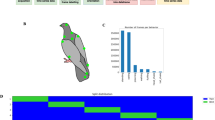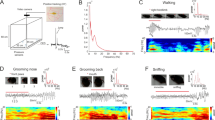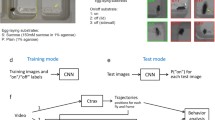Abstract
Computational Ethology is the study of the animal behavior using advances in the field of Computer Vision and Artificial Intelligence. This field of research allows scientists to analyse and characterise behaviors and find out the differences that exist between distinct diseases or disorders for pharmacological studies. In this work we will analyse the data recorded with a multisensor system composed of a top video camera and a piezoelectric pressure sensor that records the movements of an animal. Specifically, this work aims to answer the research question of whether it is possible to differentiate phenotype of an animal model using transfer learning over the pressure signal alone. To do this, the piezoelectric signal will be analysed in the frequency domain by computing its spectrogram, and we segment the chunks corresponding to the locomotion events, previously detected. Convolutional neural models previously trained will be used for classification by applying a transfer learning approach. The results show that an accuracy of more than 96% is obtained and the confirmation that it is possible to classify phenotypes with the data obtained with pressure sensors.
Access this chapter
Tax calculation will be finalised at checkout
Purchases are for personal use only
Similar content being viewed by others
Notes
- 1.
Wild-type gene is a term used to describe a gene when it is found in its natural, non-mutated (unchanged) form.
- 2.
Fmr1-knockout (Fmr1-KO) mice may be useful for studying behavioral and synaptic abnormalities associated with Fragile X Syndrome.
- 3.
References
Anderson, D., Perona, P.: Toward a science of computational ethology. Neuron 84, 18–31 (2014)
Gomez-Marin, A.: A clash of umwelts: anthropomorphism in behavioral neuroscience. Behav. Brain Sci. 42, e229 (2019)
Datta, S., Anderson, D., Branson, K., Perona, P., Leifer, A.: Computational neuroethology: a call to action. Neuron 104, 11–24 (2019)
Carreño-Muñoz, M., et al.: Detecting fine and elaborate movements with piezo sensors provides non-invasive access to overlooked behavioral components. Neuropsychopharmacology 47(4), 933–943 (2022)
Weber, R.Z., Mulders, G., Kaiser, J., Tackenberg, C., Rust, R.: Deep learning-based behavioral profiling of rodent stroke recovery. BMC Biol. 20, 232 (2022)
Kirkpatrick, N.J., Butera, R.J., Chang, Y.-H.: Deeplabcut increases markerless tracking efficiency in x-ray video analysis of rodent locomotion. J. Exp. Biol. 225 (2022)
Suryanto, M.E., et al.: Using deeplabcut as a real-time and markerless tool for cardiac physiology assessment in zebrafish. Biology (Basel) 11 (2022)
Lauer, J., et al.: Multi-animal pose estimation, identification and tracking with deeplabcut. Nat. Methods 19, 496–504 (2022)
Lopes, G., Monteiro, P.: New open-source tools: using bonsai for behavioral tracking and closed-loop experiments. Front. Behav. Neurosci. 15 (2021)
Pereira, T., et al.: Fast animal pose estimation using deep neural networks. Nat. Methods 16(1), 117–125 (2019)
Pereira, T.D., et al.: Sleap: a deep learning system for multi-animal pose tracking. Nat. Methods 19, 486–495 (2022)
Kabra, M., Robie, A., Rivera-Alba, M., Branson, S., Branson, K.: Jaaba: Interactive machine learning for automatic annotation of animal behavior. Nat. Methods 10(1), 64–67 (2013)
Geuther, B., Peer, A., He, H., Sabnis, G., Philip, V., Kumar, V.: Action detection using a neural network elucidates the genetics of mouse grooming behavior. eLife 10 (2021)
Bohnslav, J., et al.: Deepethogram, a machine learning pipeline for supervised behavior classification from raw pixels. eLife 10 (2021)
Long, L., et al.: Automatic classification of cichlid behaviors using 3D convolutional residual networks. iScience 23(10) (2020)
Sakamoto, N., Kobayashi, K., Yamamoto, T., Masuko, S., Yamamoto, M., Murata, T.: Automated grooming detection of mouse by three-dimensional convolutional neural network. Front. Behav. Neurosci. 16 (2022)
Jin, T., Duan, F.: Rat behavior observation system based on transfer learning. IEEE Access 7, 62152–62162 (2019)
Ruiz, J., Pérez, J., Blázquez, J.: Arrhythmia detection using convolutional neural models. Adv. Intell. Syst. Comput. 800, 120–127 (2019)
Jhuang, H., et al.: Automated home-cage behavioural phenotyping of mice. Nat. Commun. 1(6) (2010)
Gerós, A., Magalhães, A., Aguiar, P.: Improved 3D tracking and automated classification of rodents’ behavioral activity using depth-sensing cameras. Behav. Res. Methods 52, 2156–2167 (2020)
Van Rossum, G., Drake Jr., F.L.: Python Reference Manual. Centrum voor Wiskunde en Informatica Amsterdam (1995)
Tomar, S.: Converting video formats with FFMPEG. Linux J. 2006(146), 10 (2006)
Krizhevsky, A., Sutskever, I., Hinton, G.E.: Imagenet classification with deep convolutional neural networks. In: Pereira, F., Burges, C., Bottou, L., Weinberger, K. (eds.) Advances in Neural Information Processing Systems, vol. 25. Curran Associates Inc (2012)
Szegedy, C., et al.: Going deeper with convolutions, vol. 07–12-June-2015, pp. 1–9 (2015)
He, K., Zhang, X., Ren, S., Sun, J.: Deep residual learning for image recognition. CoRR, abs/1512.03385 (2015)
Acknowledgments
This work has been partially supported by grant PRE2018-085294 funded by MCIN/AEI/10.13039 /501100011033 and by “ESF Investing in your future” through the project TIN2017-85827-P, with the grant PRE2018-085294, PID2020-116346GB-I00, and grant IT1689-22 as university research group of excellence from the Basque Government. We gratefully acknowledge the data shared by Prof. Leinekugel to test our approach.
Author information
Authors and Affiliations
Corresponding author
Editor information
Editors and Affiliations
Rights and permissions
Copyright information
© 2023 The Author(s), under exclusive license to Springer Nature Switzerland AG
About this paper
Cite this paper
Aguilar-Moreno, M., Graña, M. (2023). Phenotype Discrimination Based on Pressure Signals by Transfer Learning Approaches. In: Rojas, I., Joya, G., Catala, A. (eds) Advances in Computational Intelligence. IWANN 2023. Lecture Notes in Computer Science, vol 14135. Springer, Cham. https://doi.org/10.1007/978-3-031-43078-7_12
Download citation
DOI: https://doi.org/10.1007/978-3-031-43078-7_12
Published:
Publisher Name: Springer, Cham
Print ISBN: 978-3-031-43077-0
Online ISBN: 978-3-031-43078-7
eBook Packages: Computer ScienceComputer Science (R0)




